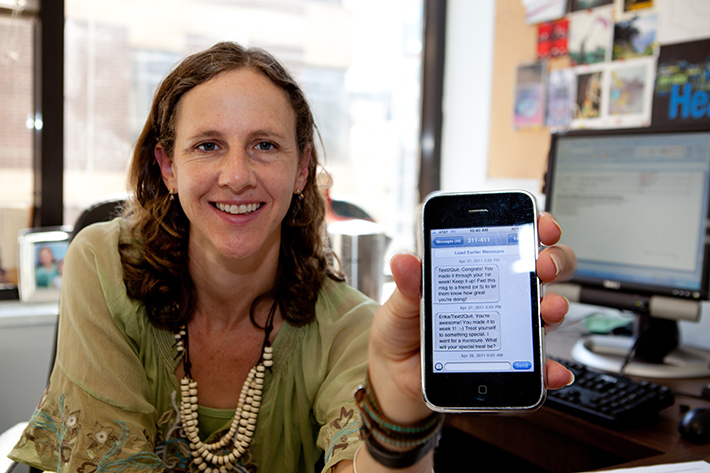Craving a cigarette? A text-messaging program can help you fight the urge to light up, according to a new study conducted by researchers at the Milken Institute School of Public Health.
More than 11 percent of smokers who used a text-messaging program to help them quit did so and remained smoke free at the end of a six-month study, compared with just 5 percent of controls, says a report that was published Friday in the American Journal of Preventive Medicine.
The research team, led by Milken Institute SPH associate professor Lorien C. Abroms, studied participants enrolled in Text2Quit—a mobile-based smoking cessation program licensed by GW, which offers personalized advice on kicking the habit based on a user’s quit date.
The text messages in the Text2Quit program also allow participants to ask for more help or to reset a quit date if they need more time. If users feel a craving coming on, they can text “CRAVE” to receive a tip or a game that might distract them. More than 75,000 people in the United States have enrolled in the Text2Quit program through quit lines, and enrollment is on the rise.
“Text messages seem to give smokers the constant reminders they need to stay focused on quitting,” Dr. Abroms said. “However, additional studies must be done to confirm this result and to look at how these programs work when coupled with other established anti-smoking therapies.”
Cigarette smoking kills nearly half a million Americans every year, according to a recent surgeon general’s report. Smokers trying to quit can turn to the tried-and-true methods like phone counseling through a quit line and nicotine replacement therapies, but the evidence is building for using text messaging on mobile phones.
Despite this, there had been no long-term studies of anti-smoking apps and texting programs. Most of the existing studies on such programs were small in size, lacked a control group and did not biochemically verify smoking status, Dr. Abroms said.
To help address such gaps, Dr. Abroms and her colleagues carried out a large, randomized trial of a text-messaging program. They recruited 503 smokers on the Internet and randomized them to receive Text2Quit or self-help material.
At the end of six months, the researchers sent out a survey to find out how many people in each group had stopped smoking. They found that people using the text-messaging program were more than twice as likely to quit, compared with the control group—a finding that suggests that text-messaging programs can provide an important boost for people struggling with a tobacco habit.
However, this study looked only at those who were already highly motivated to quit and who were already searching for quit-smoking information on the Internet.
Additional studies will have to be done to verify that text-messaging programs do in fact work in less digitally connected populations and in those with lower levels of motivation to quit. In addition, researchers will have to compare this text-messaging program with others now in use such as SmokefreeTXT, which was launched by the National Cancer Institute in 2011.


